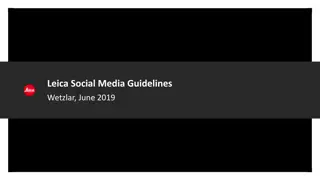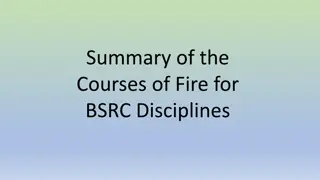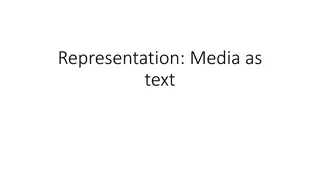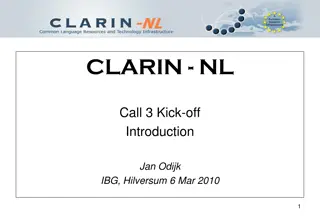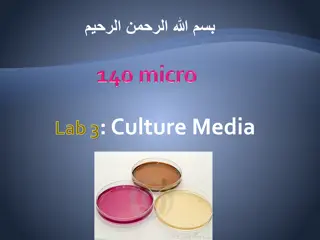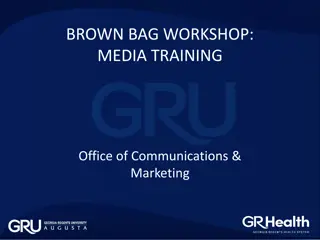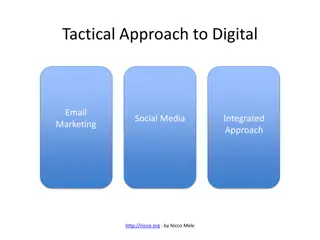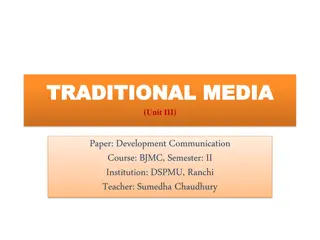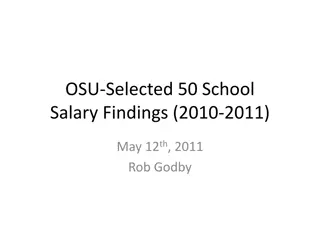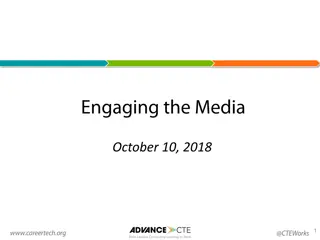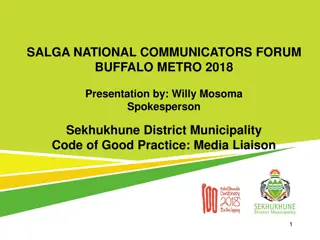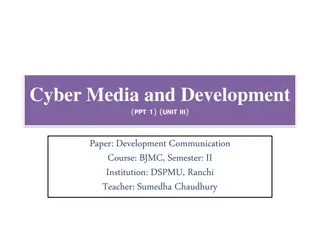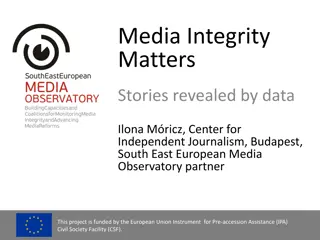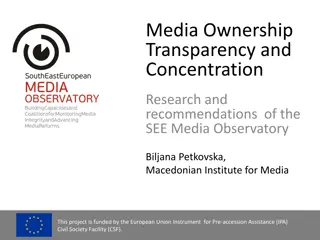Overview of Media Studies Disciplines and Historical Development
Media studies is a multidisciplinary field that explores the content, history, and effects of various media, with roots in the relationship between media and culture. Originating in the 1920s, media studies draws on traditions from social sciences and humanities, incorporating theories from disciplines such as cultural studies, philosophy, and sociology. The historical development of media studies can be traced to the UK in the 1960s, evolving from the academic study of English and literary criticism to become a prominent subject at various educational levels.
Uploaded on Jul 22, 2024 | 5 Views
Download Presentation

Please find below an Image/Link to download the presentation.
The content on the website is provided AS IS for your information and personal use only. It may not be sold, licensed, or shared on other websites without obtaining consent from the author. Download presentation by click this link. If you encounter any issues during the download, it is possible that the publisher has removed the file from their server.
E N D
Presentation Transcript
Sidi Mohammed Ben Abdellah University Faculty of letters and Human Sciences Dhar EL-Mehraz F s Department of English Studies Spring Session 2018/2019 Fundamental BA Program: Fili re : English Studies Module : Introduction to Media Studies Sadik Madani Alaoui Semester 4 Prof. :
What is Media Studies? Media studies is a discipline and field of study that deals with the content, history, andeffects of various media;inparticular,the massmedia. Media studies may draw on traditions from both the social sciences and the humanities, but mostly from communication, communication, communication sciences, and communication studies. Researchers may also develop and employ theories and methods from disciplines including cultural studies, rhetoric (including digital rhetoric), philosophy, literary theory, psychology, political economy, economics, sociology, historyandcriticism,filmtheory,feministtheory, andinformationtheory. its core disciplines of mass science, social political anthropology, theory, art
Media Studies: Paradigms and Perspectives The roots of media studies are traceable in the inquiries about the relationship between media and culture. The early attempts to this direction started during the 1920s and 1930s following the rise of mass media forms like radio networks, newspapers and magazines of mass circulation. The initial studies into media were influenced by the Eurocentric obsessions on high culture claimed by many to be the best that has been said and thought. The media of the time were assigned the role of representing that high culture ignoring the world outside Europe and colonies of European powers. The period was marked by widespread British hegemony in media production and circulation with news agencies like Reuters and BBC, which projected the image of media as powerful and influential, media as vehicles of nation-state or class propaganda, media as exemplars of modern technologically sophisticated professionalism (Boyd-Barret and Rantanen)
A Historical Overview throughout the world In the United Kingdom, media studies developed in the 1960s from the academic study of English, and from literary criticism more broadly. The key date, according to Andrew Crisell, is 1959: When Joseph Trenaman left the BBC's Further Education Unit to become the first holder of the Granada Research Fellowship in Television at Leeds University. Soon after in 1966, the Centre for Mass Communication Research was founded at Leicester University, and degree programmes in media studies began to sprout at polytechnics and other universities during the 1970s and 1980s. James Halloran at Leicester University is credited with much influence in the development of media studies and communication studies, as the head of the university's Centre for Mass Communication Research, and founder of the International Association for Media and Communication Research.]Media Studies is now taught all over the UK. It is taught at Key Stages 1 3, Entry Level, GCSE and at A level and the Scottish Qualifications Authority offers formal qualifications at a number of different levels. Much research in the field of news media studies has been led by the Reuters Institute for the Study of Journalism. Details of the research projects and results are published in the RISJ annual report
UNITED STATES OF AMERICA In USA, MASS COMMUNICATION, COMMUNICATION STUDIES OR SIMPLY 'COMMUNICATION' may be more popular names than media studies for academic departments in the United States. However, the focus of such programs sometimes excludes certain media film, book publishing, video games, etc. The title media studies may be used alone, to designate film studies and rhetorical or critical theory, or it may appear in combinations like media studies and communication to join two fields or emphasize a different focus.
GERMANY Lutz Hachmeister In Germany two main branches of media theory or media studies can be identified: The first major branch of media theory has its roots in the humanities and cultural studies, such as film studies ("Filmwissenschaft"), theater studies ("Theaterwissenschaft") and German language and literature studies ("Germanistik") as well as Comparative Literature Studies ("Komparatistik"). The second branch of media studies in Germany is comparable to Communication Studies. Pioneered by Elisabeth Noelle-Neumann in the 1940s, this branch studies mass media, its institutions and its effects on society and individuals. The German Institute for Media and Communication Policy, founded in 2005 by media scholar Lutz Hachmeister, is one of the few independent research institutions that is dedicated to issues surrounding media and communications policies. The term Wissenschaft cannot be translated straightforwardly as studies, as it calls to mind both scientific methods and the humanities. Accordingly, German media theory combines philosophy, psychoanalysis, history, and scienctific studies with media-specific research.
FRANCE Pierre Bourdieu In France, one prominent French media critic is the sociologist Pierre Bourdieu who wrote among other books On Television (New Press, 1999). Bourdieu's analysis is that television provides far less autonomy, or freedom, than we think. In his view, the market (which implies the hunt for higher advertising revenue) not only imposes uniformity and banality, but also a form of invisible censorship.
CANADA Harold Innis and Marshall McLuhan In Canada, media studies and communication studies are incorporated in the same departments and cover a wide range of approaches from critical theory to organizations to research-creation and political economy, for example. Over time, research developed to employ theories and methods from cultural studies, philosophy, political economy, gender, sexuality and race theory, management, rhetoric, film theory, sociology, and anthropology. Harold Innis and Marshall McLuhan are famous Canadian scholars for their contributions to the fields of media ecology and political economy in the 20th century. They were both important members of the Toronto School of Communication at the time. More recently, the School of Montreal and its founder James R. Taylor significantly contributed to the field of organizational communication by focusing on the ontological processes of organizations. In his book Understanding Media, The Extensions of Man , media theorist Marshall McLuhan suggested that "the medium is the message", and that all human artefacts and technologies are media. His book introduced the usage of terms such as media into our language along with other precepts, among them global village and Age of Information . A medium is anything that mediates our interaction with the world or other humans. Given this perspective, media study is not restricted to just media of communications but all forms of technology. Media and their users form an ecosystem and the study of this ecosystem is known as media ecology.
NETHERLAND In the Netherlands, media studies are split into several academic courses such as (applied) communication sciences, communication- and information sciences, communication and media, media and culture or theater, film and television sciences. Whereas communication sciences focuses on the way people communicate, be it mediated or unmediated, media studies tends to narrow the communication down to just mediated communication. However, it would be a mistake to consider media studies a specialism of communication sciences, since media make up just a small portion of the overall course. Indeed, both studies tend to borrow elements from one another.
Analysing Texts: Media and Theory Communication and media permeate our society. At its most basic level, we can think of communication as the exchange of information or meaning but what does that mean? When are you not exchanging information or meaning? To try and help make sense of the wealth of encounters in which communication might be said to be occurring, we try and categorize communication into different types. Some of these types include: Interpersonal communication, or one-on-one talking and rhetoric, where we analyse things like tone, body language, and speech Mass communication, which includes one-to-many and many-to-many communication acts, with a particular interest in mediated communication, such as with the press. Organizational communication, where we look at how people organize their information exchanges to maintain and facilitate group behaviour Intercultural communication, which looks at the exchange of information and ideas across different cultural groups or subgroups.
MODELS OF MEDIA STUDIES Building on work started by Robert T. Craig, we can generally talk about seven models or traditions of communication we can look at any communication practice through the lens of one or more of these models to develop a more nuanced understanding of communication in everyday life. The seven models are: 1. Rhetorical this model is concerned primarily with communication as a discourse, and tends to concern itself primarily with interpersonal, one-to-one or one-to-few communication acts, such as speech. Post the linguistic turn of the mid- to late-twentieth century, rhetoric has expanded its area of focus to include mass communication that attempts to persuade, such as political communication and advertising. A rhetorical approach to communication might look at who was speaking to whom, in what context, and to what end or purpose (i.e.: to persuade or to change an opinion or belief). 2. Semiotic this model sees communication primarily as an exchange of signs within a meaning-making system. We will be going into much further depth into the idea of semiotics in a later module, but for now it is just worth noting that semiotics approaches communication in itself, seeing the communication as a sign within a sign system, which employs signs in culturally contextualized combinations to convey meaning.
3. Phenomenological this model is primarily concerned with communication as an experience. A phenomenological approach would see communication as both a representation and a reinforcement of what the communicators see to be self-evident. A phenomenological approach can take on both interpersonal and mass communications, and may also take under its purvey objects or ideas as sites of meaning-making. 4. Cybernetic this model views communication as a flow of information. This is not just the pragmatic A sends a message to B type of flow, but also tries to take into account factors which influence and constraint the flow of information, including social factors such as mores and etiquette, technological factors such as channel access and availability, and political factors such as regulation. 5. Psychological or Socio-psychological this model, as the name suggests, is concerned with the impact of communication acts on the individual, particularly their sense of self in society. This model sees communication as representing certain individual choices made in order to maximize benefit to the individual or group. We ll come back to these ideas when we discuss symbolic interactionismin the next module. 6. Sociocultural this model sees communication as a way of replicating and reinforcing (and challenging) the social order. This approach assumes that people in societies have models of how that society should operate; communication acts to build, reinforce, and propagate these models. 7. Critical this model views communication as a set of assumptions that are open to challenge and negotiation; as you might have guessed, it has strong links to the socio-cultural tradition. Approaches such as Marxist critique are representative of this model. (adapted from Miller)
What might be some of the cultural roles of communication/Media in everyday life? Role 1: Communication tells stories, and perhaps more importantly, they retell stories. Communication, particularly mass communication and the mass media, tends to fall into repetitive and recursive patterns of representation and ideology, ones that often reinforce the dominant hegemony of a culture or society. For example, the narratives around masculinity and sports such as rugby think of the way stories about All Blacks are constructed and reconstructed in the media. By using these narrative strategies in our communication patterns, we are engaging in a kind of shorthand that facilitates communication behaviours, signals a shared culture or values system, and indicates an expectation of communicative and ideological symmetry. However, such myths also propagate a particular set of ideas about what is valued within a culture, and what or who is marginalized
Craig, Robert T. and Heidi L Muller. Theorizing Communication: Readings Across Traditions. Los Angeles: Sage Publications, 2007. Miller, K. Communication Theories: Perspectives, Processes and Contexts. 2ndEd. McGaw Hill: New York, 2005. Pp 1-16 Role 2: Media plays a great role in everyday life is to help maintain social order by taking on a kind of surveillance operation. Media demonstrates to a society what behaviours are considered acceptable and unacceptable. This may be through object representation, or it may be through commentary on active behaviours. An example of the former might be soaps. Soaps like Lalla Fatima plays out, in a mass media, the narratives of types of private lives and decision processes of different groups of people in a palatable, easy to understand and follow manner. structured to play out long-form life narratives, with different characters taking on the role of hero or villain. An example of commentary might be gossip, whether about a sports star, a pop singer, or your neighbours. Both are
Craig, Robert T. and Heidi L Muller. Theorizing Communication: Readings Across Traditions. Los Angeles: Sage Publications, 2007. Miller, K. Communication Theories: Perspectives, Processes and Contexts. 2ndEd. McGaw Hill: New York, 2005. Pp 1-16 Role 3: A third role that communication/Media plays is to help us interpret and make sense of information. This has become a particularly important role in the modern communication landscape, as information overload has become an increasingly common part of our everyday lives. Again, new media and electronic communication channels have raised the profile of this role of communication in everyday life. We can see this most clearly in news media, and the idea of agenda setting, but even the use of particular language or even images can also frame a topic or give subtle hints and clues as to how we are meant to interpret information according to our culture.
Craig, Robert T. and Heidi L Muller. Theorizing Communication: Readings Across Traditions. Los Angeles: Sage Publications, 2007. Miller, K. Communication Theories: Perspectives, Processes and Contexts. 2ndEd. McGaw Hill: New York, 2005. Pp 1-16 Role 4: This act of interpreting, of governing behavior, and even of storytelling, is of course at its heart a representation of a particular set of values and ideologies that emerge from and are part of a culture. It is very important to remember that no act of communication is ideologically neutral! Ideologies are part of our life worlds, part of the assumptions we make and encode into and decode out of our communication practices and behaviors, and so if we are to study communication, we need to address these ideological underpinnings.
Craig, Robert T. and Heidi L Muller. Theorizing Communication: Readings Across Traditions. Los Angeles: Sage Publications, 2007. Miller, K. Communication Theories: Perspectives, Processes and Contexts. 2ndEd. McGaw Hill: New York, 2005. Pp 1-16 Role 5: That s not to say that we always communicate thinking about these things they are often covert, assumed and unchallenged parts of our everyday lives. But they exist, even when we think about communication on a basic uses and gratifications level. Uses and gratifications is a very simple theory you may already be familiar with at some level. It hypothesizes that audiences, and communicators in general, are active in why they seek out media and communicative exchanges. These four reasons are diversion, socialization, identity, and surveillance. We may have multiple simultaneous reasons, or we may just be bored and channel surfing. But even those decisions and positions to be bored, to seek our diversion through television rather than another way, or to settle on a particular channel or show reflect ideologies and social, technological, and political pressures that are so every day that we don t even think about them anymore.
Conclusion So, to recap. Communication/Media is pervasive and an integral part of our everyday lives we cannot imagine our world without communication. Communication serves a number of concurrent functions in society pragmatic, normative, ideological and informational. We can approach an analysis of communication at a number of different levels rhetorical, semiotic, phenomenological, cybernetic, socio-psychological, socio-cultural or critical. Communication also propagates what a society considers to be normal or normative behavior. It reinforces the dominant ideologies of a society, and may also create space for new ideologies to come in and challenge that dominant hegemony. We can see these ideological debates being played out as people challenge and critique existing stories and narratives that permeate and propagate through our communicative culture. We can break communication down to the level of the individual sign, or scale it up to see it play out over time across an entire culture, but communication/media is never ideologically neutral.





